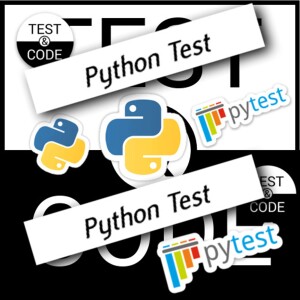
An overview of the pytest flags that help with debugging.
From Chapter 13, Debugging Test Failures, of Python Testing with pytest, 2nd edition (https://pythontest.com/pytest-book/).
pytest includes quite a few command-line flags that are useful for debugging.
We talk about thes flags in this episode.
Flags for selecting which tests to run, in which order, and when to stop:
* -lf / --last-failed: Runs just the tests that failed last.
* -ff / --failed-failed: Runs all the tests, starting with the last failed.
* -x / --exitfirst: Stops the tests session afterEd: after?Author: yep the first failure.
* --maxfail=num: Stops the tests after num failures.
* -nf / --new-first: Runs all the tests, ordered by file modification time.
* --sw / --stepwise: Stops the tests at the first failure. Starts the tests at the
last failure next time.
* --sw-skip / --stepwise-skip: Same as --sw, but skips the first failure.
Flags to control pytest output:
* -v / --verbose Displays all the test names, passing or failing.
* --tb=[auto/long/short/line/native/no] Controls the traceback style.
* -l / --showlocals Displays local variables alongside the stacktrace.
Flags to start a command-line debugger:
* --pdb Starts an interactive debugging session at the point of failure.
* --trace Starts the pdb source-code debugger immediately when running each test.
* --pdbcls Uses alternatives to pdb, such as IPython’s debugger with –-pdbcls=IPython.terminal.debugger:TerminalPdb.
This list is also found in Chapter 13 of Python Testing with pytest, 2nd edition (https://pythontest.com/pytest-book/).
The chapter is "Debugging Test Failures" and covers way more than just debug flags, while walking through debugging 2 test failures.
view more
More Episodes
161: Waste in Software Development
 2021-07-20
2021-07-20
 2021-07-20
2021-07-20
158: TDD in Swift - Gio
 2021-06-18
2021-06-18
 2021-06-18
2021-06-18
157: pre-commit - Anthony Sottile
 2021-06-11
2021-06-11
 2021-06-11
2021-06-11
152: Python Packaging - Brett Cannon
 2021-05-07
2021-05-07
 2021-05-07
2021-05-07
151: Python Adventure - Brandon Rhodes
 2021-04-28
2021-04-28
 2021-04-28
2021-04-28
150: A Practical Testing Strategy
 2021-04-15
2021-04-15
 2021-04-15
2021-04-15
148: Coverage.py and testing packages
 2021-03-12
2021-03-12
 2021-03-12
2021-03-12
145: For Those About to Mock - Michael Foord
 2021-02-18
2021-02-18
 2021-02-18
2021-02-18
144: TDD in Science - Martin Héroux
 2021-02-13
2021-02-13
 2021-02-13
2021-02-13
143: pytest markers - Anthony Sottile
 2021-02-07
2021-02-07
 2021-02-07
2021-02-07
142: MongoDB - Mark Smith
 2021-01-25
2021-01-25
 2021-01-25
2021-01-25
012345678910111213141516171819
Create your
podcast in
minutes
- Full-featured podcast site
- Unlimited storage and bandwidth
- Comprehensive podcast stats
- Distribute to Apple Podcasts, Spotify, and more
- Make money with your podcast
It is Free
- Privacy Policy
- Cookie Policy
- Terms of Use
- Consent Preferences
- Copyright © 2015-2024 Podbean.com





